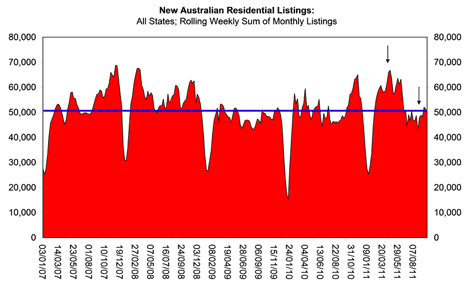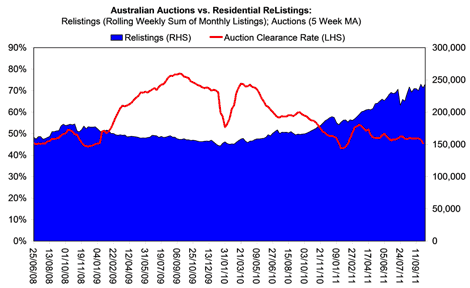Spring market lacklustre, and improvement is in the hands of the RBA
This will be a short column today looking at what is happening to the “liquidity” of Australia’s housing market right now. We measure liquidity many ways, including by reference to actual turnover, the flow of homes coming on to the market each week, the stock of homes that are relisted for sale (think of this as an inventory metric), and auction clearance rates.
Today I will focus on new listings, re-listings and auction clearance rates. All of this data is kindly supplied by RPData.com. The first chart below shows the rolling monthly new listings of homes across Australia reported on a weekly basis. There are two things we can learn from this information. First, there was an unseasonably strong spike in new listings at the start of 2011, which, as we know, coincided with the east coast floods and the general weakening in market activity. Click to enlarge
The second thing we can see is that the vendor dynamics changed abruptly in June 2011, wherein new listings fell away strikingly. While this was partly seasonal, it was also probably fuelled by the negative sentiment that was building around house prices at the time combined with the RBA’s jawboning on interest rates. We know, for example, that between February and June 2011 Australians typically expected the RBA to hike interest rates another two to three times, which would have pushed official headline mortgage rates over 8.5% (i.e., highly restrictive territory).
The final point of note in this chart is that despite the data running through the first week of October, we have yet to identify the traditional spring surge in listings. While there will inevitably be some uplift evinced, it would seem that many vendors don’t need to sell their homes, which makes sense given Australia’s relatively low mortgage default rate (about 0.8% of all borrowers). This has been doubtless reinforced by the lacklustre auction clearance rates.
The more intriguing question is whether the big shift in consumer sentiment that I have been forecasting for a while now — i.e., from expecting several rate hikes to no hikes or a cut — will feed back into more positive housing market dynamics (I expect it will).
We have seen from the latest ABS and AFG data some healthy housing finance flows over June, July and August. As previously reported, we have also witnessed a gradual increase in the share of first-time buyers returning to the market. There is no question that affordability has improved: house prices have not risen in over a year while disposable incomes have been expanding at an 8% per annum pace. Finally, we know that the use of fixed-rate loans is increasing sharply given that you can now fix for three years at low rates below 6%.
The second chart I want to highlight is the stock of unsold homes, or re-listings, over time. I have juxtaposed this against the national auction clearance rate. The lessons are clear: the decline in the clearance rate from over 70% in 2009 to around 50% today has correlated with an inexorable rise in the volume of homes that are available for sale (since more are getting passed in). So while new listings coming to market are low, the overall inventory of properties available for purchase is high. This accords with the soggy price action that we have seen throughout 2011, with combined capital city dwelling values down about 3% to 4% in the year to date. Click to enlargeWhat happens for the remainder of the year really hinges on interest rates. If the RBA cuts or stays on hold with an easing bias, we expect to see a noticeable uplift in housing virility. If in the now increasingly unlikely event — at least according to the financial markets and most economists — the RBA were to consider raising rates again, conditions would obviously remain very limp indeed.
Christopher Joye is a leading financial economist and works with Rismark International. Rismark and RP Data provide house price analytics products, and solutions that enable investors to go long and/or short the housing market. The above article is not investment advice.


